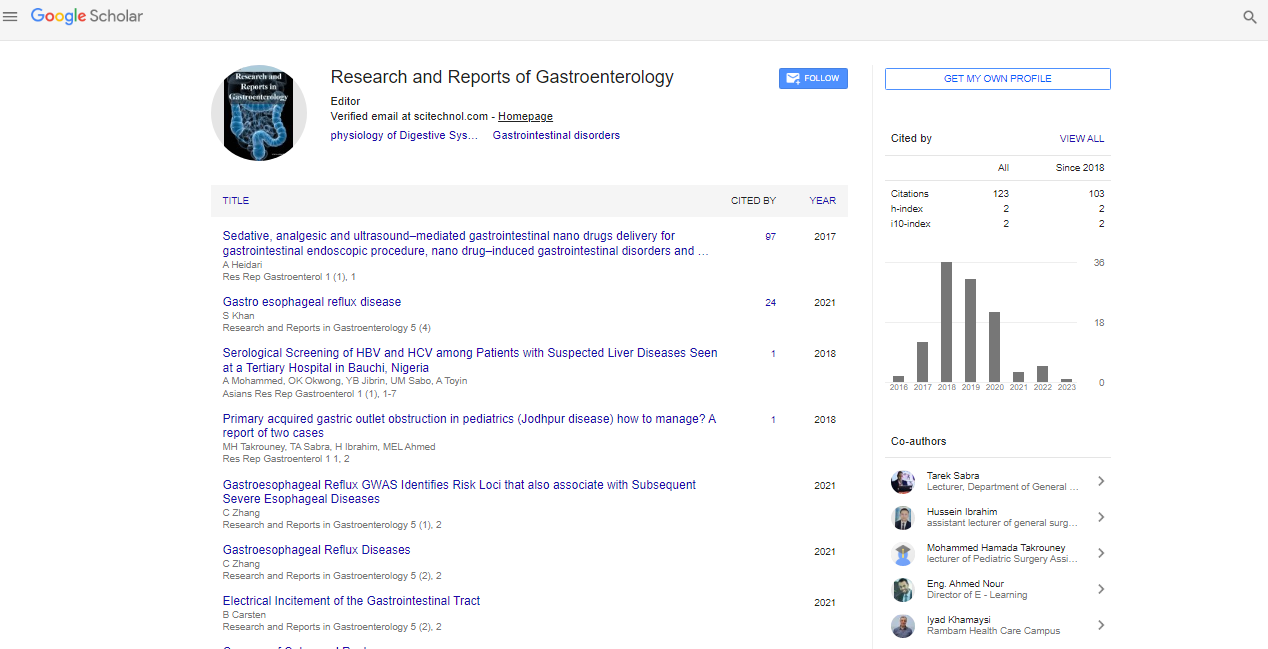Opinion Article, Res Rep Gastroenterol Vol: 7 Issue: 1
Introduction to the Digestive System
Jobia Jolex*
Department of Oncology, University of Birmingham, Birmingham, United Kingdom
*Corresponding Author: Jobia Jolex
Department of Oncology, University of Birmingham, Birmingham, United Kingdom
E-mail: jolex56@gmail.com
Received date: 20 February, 2023, Manuscript No. RRG-23-97823;
Editor assigned date: 22 February, 2023, PreQC No. RRG-23-97823 (PQ);
Reviewed date: 08 March, 2023, QC No. RRG-23-97823;
Revised date: 15 March, 2023, Manuscript No. RRG-23-97823 (R);
Published date: 23 March, 2023, DOI: 10.4172/Rrg.1000134
Citation: Jolex J (2023) Introduction to the Digestive System. Res Rep Gastroenterol 7:1.
Description
The digestive system is a complex network of organs and tissues that work together to break down food into nutrients that can be absorbed by the body. It plays a crucial role in maintaining our overall health and wellbeing by converting the food we eat into energy, while also eliminating waste and toxins.
The digestive system begins in the mouth, where food is first broken down by the teeth and saliva. Saliva contains enzymes that start to break down carbohydrates, and the tongue helps to push the food to the back of the throat. From there, the food enters the esophagus, a long muscular tube that connects the mouth to the stomach.
The stomach is a muscular sac that stores and churns food, mixing it with gastric juices that contain enzymes and hydrochloric acid. These juices help to break down the food further, turning it into a liquid called chyme. The stomach also plays a role in regulating the release of food into the small intestine, which is the primary site of nutrient absorption.
The small intestine is a long, narrow tube that is divided into three sections: the duodenum, the jejunum, and the ileum. It is here that most of the nutrients from the food we eat are absorbed into the bloodstream. The walls of the small intestine are lined with tiny finger-like projections called villi, which increase the surface area of the intestinal wall and allow for more efficient absorption of nutrients.
The large intestine, also known as the colon, is the final part of the digestive system. It is responsible for absorbing water and electrolytes from the remaining waste material and forming it into feces. The feces are then stored in the rectum until they are eliminated through the anus during a bowel movement.
The digestive system is regulated by a complex network of hormones, nerves, and muscles that work together to ensure that food is broken down and absorbed properly. One of the most important hormones involved in this process is gastrin, which is produced by cells in the stomach in response to the presence of food. Gastrin stimulates the production of gastric juices and helps to regulate the movement of food through the digestive system.
Another important hormone is cholecystokinin, which is produced by cells in the small intestine in response to the presence of fat and protein. Cholecystokinin stimulates the release of bile from the gallbladder, which helps to break down fats in the small intestine.
The nervous system also plays a critical role in regulating digestion. The enteric nervous system, which is sometimes called the “second brain,” consists of a complex network of neurons and neurotransmitters that are involved in controlling the movement of food through the digestive system. This system is capable of working independently of the brain, which allows it to continue functioning even when the brain is not actively involved.
While the digestive system is essential for maintaining our health and wellbeing, it is also vulnerable to a wide range of disorders and diseases. Some of the most common digestive disorders include Gastroesophageal Reflux Disease (GERD), Irritable Bowel Syndrome (IBS), Inflammatory Bowel Disease (IBD), and celiac disease.
GERD occurs when the muscles at the bottom of the esophagus fail to close properly, allowing stomach acid to flow back up into the esophagus. This can cause symptoms such as heartburn, chest pain, and difficulty swallowing.
IBS is a chronic condition that affects the large intestine, causing symptoms such as abdominal pain, bloating, and diarrhea or constipation. While the exact cause of IBS is not known, it is believed to be related to abnormalities in the muscles and nerves of the digestive system.
IBD is a group of chronic inflammatory disorders that affect the digestive tract, including Crohn’s disease and ulcerative colitis. These conditions can cause severe symptoms such as abdominal pain.
 Spanish
Spanish  Chinese
Chinese  Russian
Russian  German
German  French
French  Japanese
Japanese  Portuguese
Portuguese  Hindi
Hindi 